Search myodfw.com
The Golden eagle is the largest soaring raptor inhabiting open country and mountainous terrain in eastern Oregon. A powerful and skillful hunter, the Golden eagle has become the National icon of the American West. A very large, dark raptor, the nape golden in all plumages, the females are slightly larger. Juvenile birds show white patches at the base of the primaries and a white tail with a broad dark terminal band. They are common residents in all Oregon counties east of the Cascade range. The Golden eagle inhabits shrub-steppe, grassland, juniper, and open ponderosa pine and mixed conifer/deciduous habitats. It
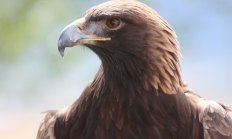
The enigmatic Solitary sandpiper may be one of the least understood of Oregon's regularly occurring shorebirds. As its name implies, the species is most often found singly, and it rarely occurs in groups of more than two individuals. The Solitary sandpiper frequents habitats not often utilized by other migrant shorebirds, such as smaller and often partly wooded patches of water, and high-altitude bogs and wet meadows. It is an uncommon to rare migrant in fresh water or brackish habitats throughout Oregon; rarest along outer coast and in alkali habitats. Spring adults more common in the western interior valleys; fall juveniles

This tall, pale wader is often first detected by its ringing calls as a small flock maneuvers to land in shallow water along an estuary or lakeshore. The long, often slightly upturned bill and very long yellow legs make this one of the easier shorebirds to identify despite its subdued, speckled gray and white plumage. It is an uncommon to locally common migrant on shorelines and open wet areas statewide. It winters on the coast and locally inland. In addition to using shallow water in estuaries and along lake margins, these birds can often be found in flooded pastureland, especially
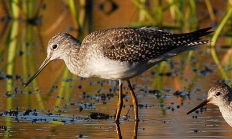
A large, long-legged wader distinguished from similar species in a flight by flashing rufous underwings and dark brown primaries. Its feet extend beyond tail tip in flight. Flocks generally consist of fewer than 50 birds on the coast. Juveniles migrate south several weeks later than most adults. After mid-November, a few stragglers are seen until late December. The Marbled godwit is a regular spring and fall migrant on the Oregon coast. Spring migration commences in early April and extends through early June on the coast. Its average arrival at the Malheur National Wildlife Reserve is April 27. Hear the call

The noisy and frenetic Ruddy turnstone is a stocky, plover-like bird who's breeding plumage is a clown like pattern of black, rust and white. Ruddy turnstones have been found foraging in the company of many other shorebird species. Found on rocky shores, jetties, open ocean beaches, mud flats, salicornia marshes, grass flats and flooded fields, the Ruddy turnstone is an opportunistic feeder. It is an uncommon to common spring and fall transient along the coast; a few birds remain to winter there each year. The largest flocks are seen during spring and fall migration at Bandon. They are an irregular

The nasal meow of the Franklin's gull can be heard as it soars above wetlands and meadows, and colonies of this species are reported to be the loudest of all the gulls. In breeding plumage, the black hood contrasts sharply with the white breast and bright red bill. This species depends much more on insects and other invertebrates than do other gulls, and is therefore considered economically beneficial and favored by farmers. The Franklin's gull occurs in the southeast portion of the state in spring and summer, especially Harney Basin. It is rare west of the Cascades. It nests locally

During the breeding season Pigeon guillemots are easily seen flying low over the water along rocky coastlines or in estuaries. They have striking red feet, legs, and mouth linings and their large white wing patches contrast markedly with the rest of their black plumage. When standing on land they have a distinctive upright posture and often emit a high-pitched squeal. In the non breeding season they move offshore and look entirely different when their black plumage becomes mottled with white. The Pigeon guillemot occurs during the breeding season all along the Oregon coast wherever offshore islands or rocky cliffs are

One of the most startling sounds in the black of night is the loud, harsh call of the Barn owl as it flies over field or marsh in search of small rodents. They are white to tan beneath with fine spotting ranging from almost none to fairly extensive. The face has a well-defined facial disc that acts as a parabolic dish collecting the faint sounds of its prey, allowing it to hunt successfully in total darkness. Male and female Barn owls are similar in appearance though the female is somewhat larger. The Barn owl is a fairly common permanent resident
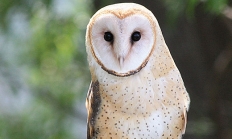
This diminutive owl is one of the smallest in North America, with a body mass of about 1.9 ounces. It has dark eyes, brown plumage with darker and reddish variegations, and small ear tufts. The Flammulated owl is unique among owls in the Pacific Northwest in that it preys almost exclusively on insects and is a neotropical migrant. Additionally, the pitch of its rather ventriloquial hoot is among the lowest of all North American owls. The Flammulated owl breeds on the eastern slope of the Cascades, in the Blue and Wallowa mountains, and in small numbers in the mountains of
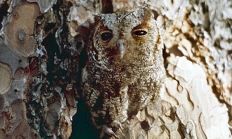
Because of its association with old forests, this inconspicuous, dark brown owl has become one of the most controversial birds in the Pacific Northwest. The dark eyes and creamy white mottling on the breast and abdomen are distinctive, as is the lack of fear of humans. Both adults and young will typically allow humans to approach within a few feet, and it is not unusual for curious juveniles to follow hikers through the woods. The Northern spotted owl is a permanent resident in forested regions of western Oregon, from the coastal mountains to the eastern foothills of the Cascade Range

The Barred owl expanded its range from the eastern United States. It was first reported in Oregon in the early 1970s and has since spread to forested areas throughout most of the state. Sometimes confused with the closely related Northern spotted owl, the Barred owl is large with grayish-brown and white feathers and stripes on its chest and throat. It is easily distinguished from the Northern spotted owl by the pronounced horizontal barring across the throat and upper breast, and vertical brown streaks on the lower breast and abdomen. The Barred owl is now a permanent resident in forests of
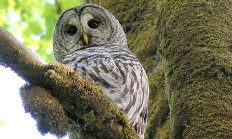
The Common nighthawk is a migrant to Oregon with one of the longest migration distances of any North American bird. It is also one of the last to arrive in Oregon. Long, slender wings are marked by a white patch on the "hand" visible in flight from great distances. When perched on the ground, the cryptic brown, gray, and black mottling makes the bird almost invisible. This bird breeds and migrates at all elevations through the state. Its nesting habitat is characterized by open landscapes with little ground cover and is most abundant in sagebrush and rocky scablands and rimrock

The down-slurred pee-eer call of this flycatcher is one of Oregon's most characteristic summertime bird sounds. Wherever there is a canopy of mature deciduous trees, one is likely to hear the call during warm afternoons when most other birds are silent. Because the call can easily be heard, it can usually be found perched near the tip of a dead branch from which it frequently flies a short distance to capture a flying insect, or to chase an intruder from its territory. The Western wood-pewee is a common migrant and fairly common breeder statewide in open groves of trees or
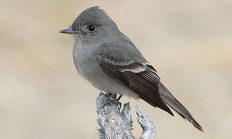
This colonial-nesting swallow places its nest at the end of a burrow dug into a soft cliff or bank. The nesting cliff often appears riddled with holes, but not all burrows are used for nesting. A highly social species, the Bank swallow is usually observed in flocks of its own or with other swallow species. It has dark wings and tail that contrast with the paler brown back. The underparts are whitish except for a distinct brown breastband. It is a generally uncommon, but locally common to abundant summer resident at mid- to low elevations east of the Cascades. Numerous

Among the largest of the world's nuthatches, White-breasted nuthatches also are noteworthy for an extensive repertoire of unusual behaviors and habits. Unlike most other North American passerines, White-breasted nuthatches maintain close pair bonds over most of the year. In spring, they cement their pair bond by exhibiting a variety of courtship displays. Elaborate display rituals also are used in antagonistic territorial interactions, and distraction displays are used to deter predators. The White-breasted nuthatch is common in western Oregon lowlands. It is most abundant in southwestern interior valleys, with specimens from Salem to Jackson County. It occurs in oak and mixed

Appropriately named, adult long-toed salamanders have extremely long toes on their hind feet. Adults have black or brown skin that is smooth and moist with a yellow ragged-edged stripe running from its head to the tip of its tail. It is speckled with white or silver dots along its sides and underside. Adults may grow up to more than six inches in total length. Adult long-toed salamanders are seen infrequently, as they spend most of the year in the ground. They find cover in a variety of habitats including grasslands, dry shrub-steppe, pastures, lowland forests, high elevation lakes and ponds
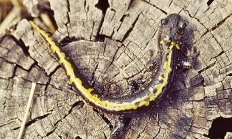
Adult Cascades frogs have tan, copper or green backs with black spots and yellow bellies. Their skin has small bumps on the back and sides. Females, which grow to three inches in length, are slightly larger than males. Cascades frogs live in a variety of moist habitats including mountain meadows, bogs, seasonally flooded forested swamps and shallow ponds, marshes and lakes. They use woody debris, mud or dense vegetation for cover from predators and spend their winters hibernating in mud. They emerge during the summer and live in wet meadows and bogs or along forested streams and pond edges. The
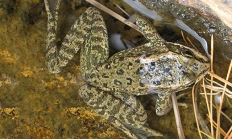
The drake gadwall is a large mostly gray dabbling duck. Adult drakes have a black bill, buff head, gray body, and black upper and lower tail coverts. Hens are nondescript brown ducks with a spotted, yellowish-orange bill with black edges. Gadwalls are unique among dabbling ducks in having a partly white speculum which can be observed in flight. Common vocalizations include the deep, reed-like sounds of the male and the female's quacking, similar to but more nasal and higher pitched than the mallard hen. It is an abundant breeder locally in eastern Oregon and an uncommon breeder in western Oregon

When mention is made of ducks, many people first think of the mallard. Its ability to tolerate human disturbance and adapt to urban as well as rural habitats make it the Northern Hemisphere's most abundant and widespread waterfowl. Females are mottled-brown, with dark brown stripe through the eye, orange bill with black splotching and have yellowish-orange legs. Immatures resemble adult females until males acquire nuptial plumage usually by mid-November. Males enter the eclipse molt in June and resemble hens until mid-September. Wings of both sexes have a violet-blue speculum bordered in front and behind by a pronounced white stripe. They

Known as "bluebill" to most hunters, this species is one of the most abundant and widespread of North American ducks. The lesser scaup is similar to the greater scaup in appearance and habits, but is smaller and lacks the white on the primaries. In the field, however, the black-and-white drakes and brown hens are very similar to greater scaups. The common vocalization is the purr call of the female; drakes are usually silent, but utter a low single-note whistle in courtship. In general, the lesser scaup is more apt to be found in interior or freshwater habitats while the greater

